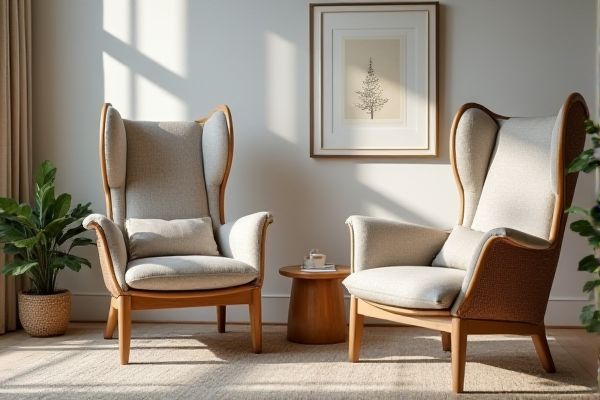
Choosing between a low-back chair and a high-back chair depends on your ergonomic needs and comfort preferences, with low-back chairs offering greater flexibility and high-back chairs providing enhanced neck and upper back support. Explore this article to find out which chair best suits your posture and workspace requirements.
Table of Comparison
| Feature | Low-Back Chair | High-Back Chair |
|---|---|---|
| Back Support | Supports lower back (lumbar region) only | Supports entire back, including upper back and neck |
| Ergonomics | Good for short-term use and minimal back support | Better for long hours, enhanced posture support |
| Comfort | Moderate comfort, suitable for light office work | High comfort, ideal for extended sitting sessions |
| Cost | Generally more affordable | Typically more expensive due to added support features |
| Design | Compact, lightweight, easy to move | Bulkier, heavier, often with adjustable features |
| Use Case | Suitable for casual use and short meetings | Best for desk jobs, gaming, and executive office settings |
Introduction to Low-Back vs High-Back Chairs
Low-back chairs provide targeted lumbar support and promote active sitting by allowing greater upper back mobility, making them suitable for dynamic office environments. High-back chairs envelop the entire back, including shoulders and neck, offering enhanced comfort and support for prolonged sitting sessions. Choosing between low-back and high-back chairs depends on individual ergonomic needs, activity level, and duration of use.
Design Differences: Low-Back vs High-Back Chairs
Low-back chairs feature a shorter backrest that supports the lower spine, promoting mobility and often preferred for tasks requiring frequent movement. High-back chairs offer full back coverage, supporting the upper spine, neck, and head to enhance posture and reduce fatigue during extended sitting periods. Your choice between low-back and high-back designs should consider ergonomic needs and the level of support required for comfort and productivity.
Ergonomic Benefits of Low-Back Chairs
Low-back chairs promote greater freedom of movement and encourage active sitting, reducing the risk of lower back stiffness and improving circulation. They often support natural lumbar curvature while allowing your upper back and shoulders to move more freely, which can decrease muscle tension. Choosing a low-back chair enhances ergonomic comfort, especially for tasks requiring frequent reaching or turning.
Ergonomic Benefits of High-Back Chairs
High-back chairs provide superior ergonomic support by aligning your spine and reducing pressure on the lower back compared to low-back chairs. Their extended backrest supports the entire thoracic and cervical spine, promoting better posture and reducing muscle fatigue during prolonged sitting. This enhanced support helps prevent common issues like slouching and chronic back pain, making high-back chairs ideal for long hours of desk work.
Ideal Use Cases for Low-Back Chairs
Low-back chairs are ideal for short-duration tasks and environments requiring greater mobility, such as workstation desks and conference rooms. They provide essential lumbar support while promoting active posture adjustments and increased airflow, reducing heat buildup during extended sitting. This makes low-back chairs suitable for users seeking lightweight seating with adequate ergonomic benefits in dynamic office settings.
Best Situations for High-Back Chairs
High-back chairs offer superior support for the upper back, neck, and head, making them ideal for extended periods of sitting, such as during long work hours or intense focus sessions. They enhance posture and reduce strain, benefiting individuals with back or neck discomfort. Your comfort and spinal health improve significantly in environments like executive offices or home workstations where prolonged sitting is common.
Comfort Considerations: Support and Posture
Low-back chairs provide targeted lumbar support that encourages natural spine alignment, enhancing comfort for shorter periods of sitting. High-back chairs offer comprehensive support for the entire back, including shoulders and neck, promoting better posture during extended use. Choosing the right chair depends on your specific comfort needs and how long you plan to remain seated.
Style and Aesthetics: Choosing the Right Look
Low-back chairs offer a minimalist, modern aesthetic that works well with sleek, contemporary interiors, while high-back chairs provide a more traditional, authoritative appearance suited for formal or executive spaces. You can enhance your room's ambiance by selecting a chair that complements existing furniture and overall design themes. Consider how the chair's silhouette and upholstery color influence the visual balance and style cohesion of your environment.
Price Comparison: Low-Back vs High-Back
Low-back chairs typically range from $50 to $150, offering budget-friendly options suitable for basic office use, while high-back chairs generally start around $120 and can exceed $500, reflecting their enhanced ergonomic features and superior support. Investing in a high-back chair often yields long-term benefits, such as improved posture and reduced back pain, justifying the higher upfront cost. Price variation depends on materials, brand reputation, and added features like adjustable lumbar support and headrests.
Which Chair Is Best for You?
Choosing between a low-back chair and a high-back chair depends on your ergonomic needs and work habits. Low-back chairs offer greater mobility and are ideal for tasks requiring frequent movement, while high-back chairs provide comprehensive support for your upper back and neck, reducing strain during prolonged sitting. Evaluate your work environment and body support requirements to determine which chair promotes better posture and comfort for your daily routine.
 homyna.com
homyna.com